

Clinical realism: a new literary genre and a potential tool for encouraging empathy in medical students. AURA. Art Helps Nursing and Medical Students Strengthen Observation Skills. Newswise — CHICAGO — Gazing at a painting or examining a sculpture can aid nursing and medical students in improving their observation skills, according to findings published in the April issue of the Journal of Nursing Education.
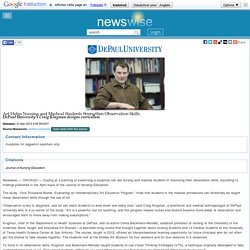
The study, “One Thousand Words: Evaluating an Interdisciplinary Art Education Program,” finds that students in the medical professions can effectively be taught visual observation skills through the use of art. Needlework project. Medicine as a performing art: what we can learn about empathic communication from theater arts. Art Rounds: Teaching Interprofessional Students Visual Think... : Academic Medicine. The 2010 Carnegie Foundation report, “Educating Physicians: A Call for Reform of Medical School and Residency,”1 discusses the importance of humanities and social science education in the formation of the physician.
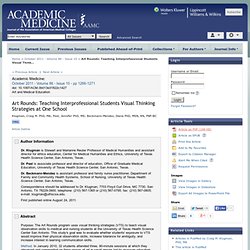
Among the report's recommendations are innovative programs that use art museums as teaching laboratories. The 2009 Harvard Libraries conference, “Art Museums and Medical Education,” included poster presentations by 10 medical schools, one nursing school, and their collaborating art institutions. Results from these innovative educational programs demonstrate that they improve participants' capacity to make accurate observations of both art and physical findings. The Chief Concern of Medicine. Unlike any existing studies of the medical humanities, The Chief Concern of Medicine brings to the examination of medical practices a thorough—and clearly articulated—exposition of the nature of narrative.
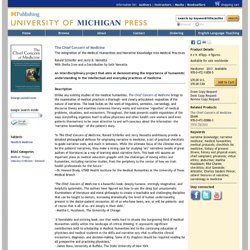
The book builds on the work of linguistics, semiotics, narratology, and discourse theory and examines numerous literary works and narrative "vignettes" of medical problems, situations, and encounters. Throughout, the book presents usable expositions of the ways storytelling organizes itself to allow physicians and other health care workers (and even patients themselves) to be more attentive to and self-conscious about the information—the "narrative knowledge"—of the patient's story.
Robert Gupta: Between music and medicine. Year-Long-Program-Information.pdf (application/pdf Object) Contemplative Dance Workshops. Enhance your practice.
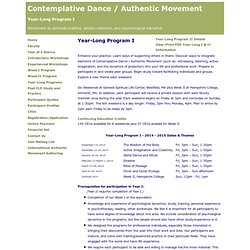
Learn ways of supporting others in theirs. Discover ways to integrate elements of Contemplative Dance / Authentic Movement (such as: witnessing, listening, active imagination, and the dynamics of projection) into your life and professional work. Prepare to participate in and create peer groups. Begin study toward facilitating individuals and groups. Explore a new theme each weekend. Six Weekends at Genesis Spiritual Life Center, Westfield, MA plus Week II at Hampshire College, Amherst, MA.
Continuing Education Credits 140 CEUs available for 6 weekends plus 37 CEUs availabl for Week II. A 12-Day Plan of Simple Writing Exercises. It’s the perfect time to restart your engine and get back into writing.

Here, I offer up a 12-day plan of simple writing exercises to help you keep your creative juices flowing without eating up too much of your time. Follow this plan and in less than half a month, you’ll not only be impressed with what you’ve accomplished, but you may also have something worth publishing. Stage Directions. Natural Pain Relief. The Impact of Group Drumming on Social-Emotional Behavior in Low-Income Children. Recreational music-making modulates immunological ... [J Med Dent Sci. 2009] - PubMed result.
Modulation of muscle responses evoked by transcran... [J Neurophysiol. 1995] - PubMed result. Topics in Stroke Rehabilitation - online access - Volume 13 - Number 1/Winter 2006 - Consumer Comments, Control, and Communication - Social Communication in Older Age: Lessons from People with Aphasia - Journal Article. Authors.

Neural substrates of spontaneous musical performan... [PLoS One. 2008] - PubMed result. A Journey into Chaos: Creativity and the Unconscious. The relationship between quilting and wellbeing. [J Public Health (Oxf). 2011] - PubMed result. Medical Problems of Performing Artists - Medical Problems of Performing Artists. Topics in Stroke Rehabilitation - online access - Volume 13 - Number 1/Winter 2006 - Consumer Comments, Control, and Communication - Social Communication in Older Age: Lessons from People with Aphasia - Journal Article. Authors Bronwyn Davidson1, Linda Worrall2, Louise Hickson3.
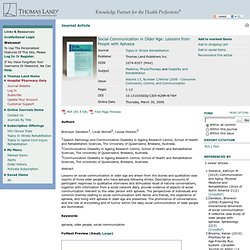
Music Making as a Tool for Promoting Brain Plasticity across the Life Span. Catherine Y.

Wan Playing a musical instrument is an intense, multisensory, and motor experience that usually commences at an early age and requires the acquisition and maintenance of a range of skills over the course of a musician’s lifetime. Thus, musicians offer an excellent human model for studying the brain effects of acquiring specialized sensorimotor skills. For example, musicians learn and repeatedly practice the association of motor actions with specific sound and visual patterns (musical notation) while receiving continuous multisensory feedback. This association learning can strengthen connections between auditory and motor regions (e.g., arcuate fasciculus) while activating multimodal integration regions (e.g., around the intraparietal sulcus) . © The Author(s) 2010. Resources For Adults. Make Activities for Survivors: Write a love letter to yourself and mail it to yourself.

Collect quotes from family, friends, authors that contain positive affirmations and place them all over room/house. Make an art piece that represents your past, present and future. ‘Compulsory creativity’: rationales, recipes, and results in the placement of mandatory creative endeavour in a medical undergraduate curriculum. Being Ernest: John Walsh unravels the mystery behind Hemingway's suicide - Profiles, People. His death was timed at 7am.
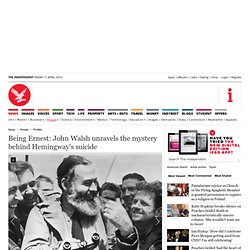
Witnesses who saw the body remarked that he had chosen from his wardrobe a favourite dressing gown that he called his "emperor's robe". They might have been reminded of the words of Shakespeare's Cleopatra, just before she applied the asp to her flesh: "Give me my robe. Put on my crown; I have immortal longings in me". His widow Mary told the media that it was an unfortunate accident, that Ernest had been cleaning one of his guns when it accidentally went off. The story was splashed on the front page of all American newspapers.
The Shape of a Story, and Why We Tell/Read Stories. The keynote speaker at the Write on the Sound Writers Conference at which I did my workshop was a film writer named Brian McDonald. He had an interesting take on the shape (structure) of a story. Since storytelling in a novel and on the screen is fundamentally pretty much the same, I thought I’d share what he had to say about that, and about storytelling in general. Here are the elements of a story. They are simple, yet I think this works. To tell your story, you simply (yeah, right) complete the sentences. 1. Guest Post: Writing, Reading, and Healing. This week, I am focusing on Writing and Healing. Storytelling is a form of expression, communication, and connection. We often tell stories to share our experiences, and we read them to find out that we are not alone. Wired 7.01: The Revenge of the Intuitive. Sandra Harner Discusses Shamanism and Creativity from the Foundation for Shamanic Studies Journal, Shamanism. © Shamanism, Fall/Winter 1999, Vol. 12, No. 2 One of the great surprises that shamanism affords is the joy of the unknown and that the unknown is joyous.
There is a sense of wholeness that proceeds from the creativity that is inherent in the shamanic journey.